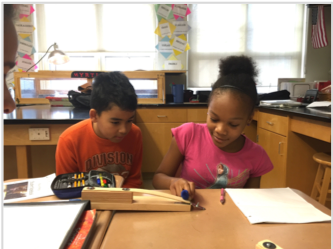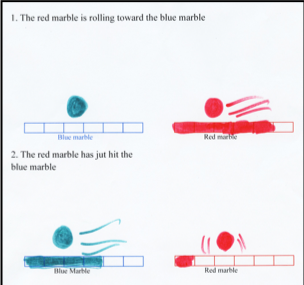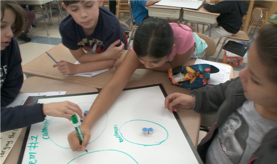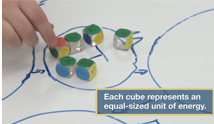Key Curriculum Features

![]() PDF of the Key Curriculum Features
PDF of the Key Curriculum Features
Focus on Energy uses an innovative approach to engage elementary students in learning about energy. Students go beyond simply identifying specific forms or transfers or transformations; they learn to track energy flow through increasingly complex systems.
There are several key features of the curriculum. Engaging in a coherent sequence of activities, students learn to use what we call the Energy Tracking Lens and they use a set of representational tools to reason about energy flow and develop a model of energy. These features provide a framework and language that enable all students to develop and use energy ideas.
 Additional information, teacher's guides and resources are available from the Curriculum menu at the top of the page.
Additional information, teacher's guides and resources are available from the Curriculum menu at the top of the page.
The Focus on Energy curriculum is comprised of a sequence of firsthand investigations of increasingly complex phenomena involving motion, elastic, thermal, and electrical energy. Each investigation is framed by an investigation question, followed by explorations and activities, and the opportunity to make meaning. Students have multiple opportunities to apply and consolidate ideas about energy forms, transformations, and transfer as they construct energy stories of ball collisions, elastic-band driven propellers, solar panels that can charge a capacitor, or temperature changes in the air of a “mini-room” warmed by a cup of hot water.
The Energy Tracking Lens provides a consistent framework and language that help students reason about energy flow in any phenomenon. The Energy Tracking Lens begins with careful observation of an interesting phenomenon. Students describe what they observe, then use those observations as evidence of energy changes that they cannot see. Through a series of questions, students identify elements they’ll need to tell the “energy story.” Telling the energy story requires using the evidence they can see to infer or reason about the energy they can’t observe directly. Implicit in the last question (Where does the energy come from and where does the energy go?) is the idea that energy is conserved—like matter, it cannot just appear or disappear, and whenever there is a decrease, there is an increase in some other forms or places. With the Energy Tracking Lens, students begin to look at energy through the eyes of a scientist.
The Energy Tracking Lens is formally introduced to students in Motion Investigation 3B.

An Emerging Classroom Model of Energy
Since energy is an inherently abstract concept that cannot be directly observed, the study of energy both demands and is an ideal context for modeling-based teaching and learning. The curriculum begins with an easy to observe motion phenomenon: a collision between a ball in motion and a stationary ball on a horizontal track. Students begin to generate a model in response to the question, "What can motion tell us about energy?" The class collectively adds to and revises the model throughout the unit uses it to construct sophisticated explanations of energy flow.
Representational schemes support model-based reasoning, and the curriculum introduces representational tools that allow students to track energy flow in a flexible, context-independent way. Students use these representations to make the invisible visible, and to reason about the energy flow.
Energy Bars


Energy bars are introduced to show gains and losses during a collision and to convey the idea of energy as a quantity. Students use the observable evidence of energy, in this case speed, to determine how many energy bars to color in. "The blue ball wasn’t moving so I gave it zero energy bars but after it collided with the red ball, it moved pretty fast so I gave it four energy bars. I think it got its energy from the red ball. The blue ball started out with five bars and after the collision it hardly moved at all so I gave it one. It lost most of its motion energy."
Students use this single, versatile representation to show changes in motion energy, elastic energy, and thermal energy, reinforcing the idea that all forms of energy are the same stuff, and that the same tools and ideas can be used to analyze energy across a wide range of phenomena.
Energy Cubes

A key Focus on Energy representational tool is Energy Cubes. Units of energy are represented by small cubes similar to dice. Cube sides are labeled to indicate different energy forms, such as M for motion or Th for thermal. Students draw circles on a whiteboard to represent what they consider the relevant components of a system. They have six energy cubes to distribute among the components, based on their reasoning from observations. The representation provides a context and tool for co-construction of meaning.

Groups of students negotiate which components to represent and how to tell the energy story. They move and flip the cubes to represent energy transfer and transformation while holding one another responsible for consistency both with their observations and their overarching model of energy.
Sketches, Diagrams and Drawings
As they create a drawing, or sketch of their ideas, students take another look at their thoughts about an energy story. As they share their ideas, they ask, "Am I accounting for everything? Does this still make sense to me?"
Armed with an emerging model of energy, a set of representational tools, and a common language, students are poised to apply energy ideas in their future school work as well as in their everyday life.